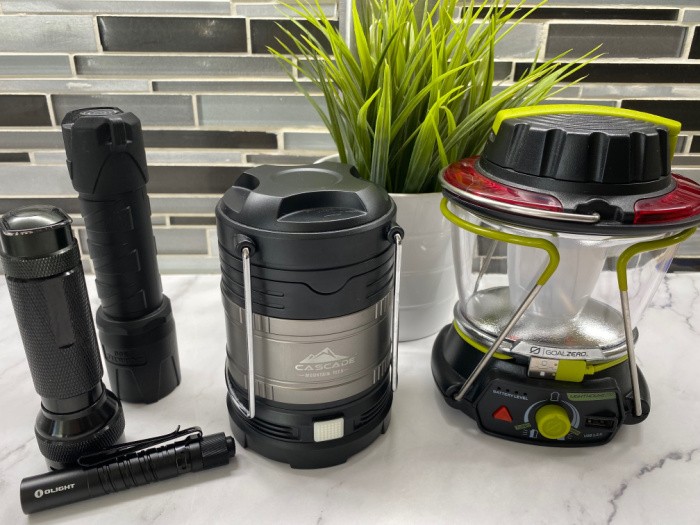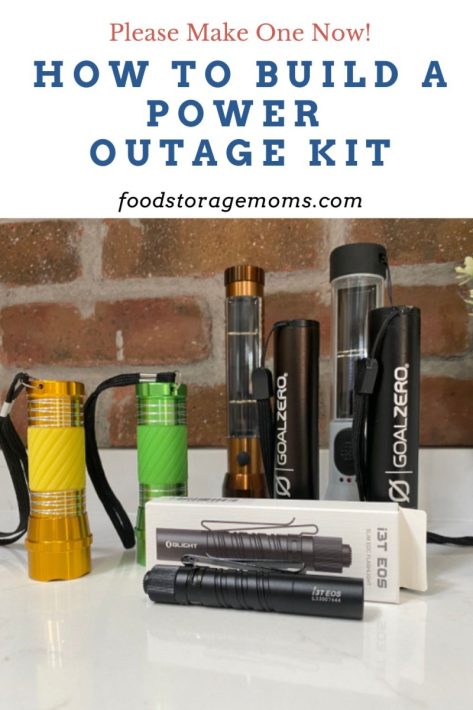
Today, I’d like to discuss how to build a power outage kit for you and your family if you lose power in your home. Some of you may be new, and some are so experienced you already have a power outage kit. I get it. But let’s teach those around us to be ready for whatever comes our way.
We sometimes have to hear this stuff repeatedly; one day, it makes us think about what we have this very minute. Or what we do not have, maybe it’s what we need to replenish our stash. Bushnell Lantern (a special friend gifted me one), and I used it daily while our house was built.

How To Build A Power Outage Kit
I can’t believe how many news reports I’ve listened to over the past few weeks regarding the challenges families face due to the increased number of storms affecting the country, particularly along the East Coast and southern states.
New Orleans has been devastated by storm-related emergencies. In case you missed it, here are the Basic Items To Gather For Any Emergency.
There hasn’t been one report I’ve listened to or read about that doesn’t mention that the affected area has seen countless thousands of homes lose power. The tricky thing about these reports is that the homes affected don’t have reliable information about the timing for their power to be restored.
I’ve been trying for years to help people of all ages, locations, financial means, and education be aware of and prepare for emergencies.
Based on the consistent experience of families losing power, whether from a hurricane, tornado, wildfire, earthquake, or other disasters, I felt it was critical to help my readers prepare for an impending power outage by teaching them how to build a power outage kit.
“Prepare Your Family For Survival” by Linda Loosli
What Should I Include in My Power Outage Kit?
Although emergencies and the related issues you deal with may differ based on what caused the power to be lost at your home and possibly the general area where you live, one key question to ask is whether you should stay in place or evacuate.
If the local disaster agencies deem it best to evacuate, that decision may be out of your control. My focus today is to help you be prepared if you are allowed to stay in your home.
I’ve listed below several items I feel are needed in your kit and consider them critical for proper preparation. The “kit” itself may end up relatively large, depending on the size of your family and the items you’ve decided to include.
Storage space could be an issue and part of your decision-making efforts. From your own experience, you may feel the need to add to or delete specific items, but I’d be surprised if you don’t recognize the value of every item.
Light Sources
it may just be me, but it sure seems like emergencies and the related loss of power happen at night more often than not. That means, unless you’ve got different sources to provide light, you’ll be at a real disadvantage if you don’t have flashlights and batteries in good working condition. I would highly recommend you check out flashlights that work on solar power.
You don’t have to check your batteries’ condition constantly; on most days, there is enough sunlight to keep them charged. I always have some on my windowsills to ensure the sun is doing its job.
Some people swear by candles. My concern with candles has always been fire safety. No matter how careful you are, particularly around children, they can tip over, get bumped, or forget when you go to bed, thus putting your family at risk for a house fire.
Lanterns can be a great light source if you’re trying to light up a larger area. Again, there could be a fire risk, so I suggest you look into some solar-powered lanterns. Yes, they cost more than flashlights but put out much more light. These are awesome: ENERGIZER Compact Rechargeable Emergency LED Flashlight.
Matches or Lighter
I’ll discuss options for cooking later, but if you decide on candles or a lantern, you’ll need some way to light them. Butane lighters will also come in handy if you need to light a fire outside your home to stay warm or cook some meals.
Household Tools
A small toolbox is always an essential addition to your preparedness stash. Be sure it includes everyday things like scissors, a pocketknife, pliers, Phillips, flat-headed screwdrivers, etc.
First Aid Kit
Heaven forbid you or a family member are injured during the emergency, but that is frequently part of the challenges to be faced and prepared for. It’s always good to have a first aid kit close by all the time, but during a power outage, it could prove critical as you try to make a safer environment for those you love.
Radio: a radio can be your friend as you try to stay informed during a power outage. Here is another item that may require batteries that work. I bought a crank radio that I can also use to get weather-related channels. I want to stay on top of what’s going on outside!
Coats, Blankets, and Towels
You could lose power during a heatwave, mainly if your local electrical utility uses rolling power outages to control the electrical power provided within its service areas.
The challenge is likely to be staying warm and possibly dry. Be sure to stock up on jackets or coats, extra blankets, and towels to keep you warm and dry off when you get wet.
Medications
It would be best if you included some doses of your daily medications. One challenge to remember is if the medication needs to be refrigerated. If so, you need a high-quality small cooler.
You’d also need some ice. Another solution would be a backup emergency battery system with solar power and a small fridge.
I don’t have a generator at my home, as I worry about having to store the fuel to run it. But I do have some backup battery systems that can power some of my kitchen appliances. I’ve also tested them to make sure they will run a CPAP unit since my son-in-law uses one every night.
Cooking Devices
whether you lose power or not during an emergency, you and your family still need to eat. Hopefully, you’ll have some food in storage that can be used, so your family doesn’t go hungry.
Hot food is always lovely, mainly if your home is cold. The old BBQ usually heats most foods, even though it isn’t designed to heat a pan. Hopefully, you will have a cast iron pan.
A few years ago, Mark and I decided to switch to a gas stove instead of the electric glass-top unit we had purchased as part of our house. It took some time to get a friend to help us run a gas line to the kitchen area, so we used a butane countertop cooking unit. Butane Stove
I was amazed at its efficiency, even though it was small. We used it for several months and found it a true lifesaver.
You all know that I have a SunOven and love it. Yes, you do need sunlight to make it work. But if you have a lengthy power outage, there should be some days when the SunOven works due to a sunny day. I’ve cooked bread, soup, casseroles, and more.
You can also try to cook outside over a fire. I wouldn’t suggest using your regular cookware for this approach since it isn’t designed for that. That’s another reason I buy and use cast-iron cookware and Dutch ovens. They are very versatile, and I use them all the time. 6-Quart Dutch Oven
Food and Water
Putting these items in a “kit” could be challenging just due to the capacity of your kit container. Just keep in mind that we all need food and to stay hydrated. As those who consider ourselves to be well prepared, we need enough food and water to be accessible to survive.
Some People May. Need Help
Someone in your household may need medical, mental, physical, or dietary help. Your kit should contain items that help to address their daily needs as best as possible.
Pets can be a unique challenge during emergencies, particularly in the dark. They can get scared just like your kids; they still need to eat and drink and may need a blanket or towel to stay warm and dry.
Are there any General Safety Guidelines I Should be Aware of?
I often refer to government sources to ensure I’ve covered the necessary bases when discussing emergencies. I’ve listed below several things FEMA tells us are important considerations during a power outage:
- Keep freezers and refrigerators closed.
- Only use generators outdoors and away from windows.
- Don’t use a gas stove to heat your home.
- Disconnect appliances and electronics to avoid damage from electrical surges.
- Use alternate plans for refrigerating medicines or power-dependent medical devices.
- If safe, go to an alternate location for heat or cooling.
- Be sure to check in on your neighbors.
- Take an inventory NOW of the items you need that rely on electricity.
- Sign up for local alerts and warning systems. Monitor weather reports.
- Install carbon monoxide detectors with battery backup.
- Determine if landlines and cell phones will continue to work without electricity.
- Use a thermometer in your refrigerator and freezer to check temperatures.
- Keep your gas tank full.
- Discard medications that need to be kept cool if they have been at room temperature for more than one day.
Additional Consideration for Your Children
I suggest you visit the American Red Cross website (www.redcross.org). This great organization steps in whenever there is an emergency or disaster.
They are concerned with the protection and safety of all family members and pay particular attention to how children are prepared to deal with an emergency.
They have an excellent tool you can use before or during an emergency to help educate your kids about what to expect in different situations and how best to react.
The tool is a brochure called “Prepare with Pedro: Disaster Preparedness Activity Book,” which you can download. It includes over 20 pages of illustrations, stories, and text that outline different types of emergencies, how to prepare for them, and how to best deal with them as individuals and families.
It walks the young people through a step-by-step process of recognizing what is happening, relying on what they’ve been taught, and following through to use the skills, tools, and know-how to help them be safe and survive. Check it out!
How To Build A Power Outage Kit
Final Word
I hope all my readers realize my goal is to help them be their best selves regarding preparation. Today’s post should help as they learn how to build a power outage kit. We all need reminders and checklists to be on top of our game.
Please take the time to prepare your “kit” starting today. I promise you you’ll be glad you did. Please let me know if I’ve forgotten items you think should have been included. May God Bless this world, Linda
The post How To Build A Power Outage Kit appeared first on Food Storage Moms.
from Food Storage Moms
No comments:
Post a Comment